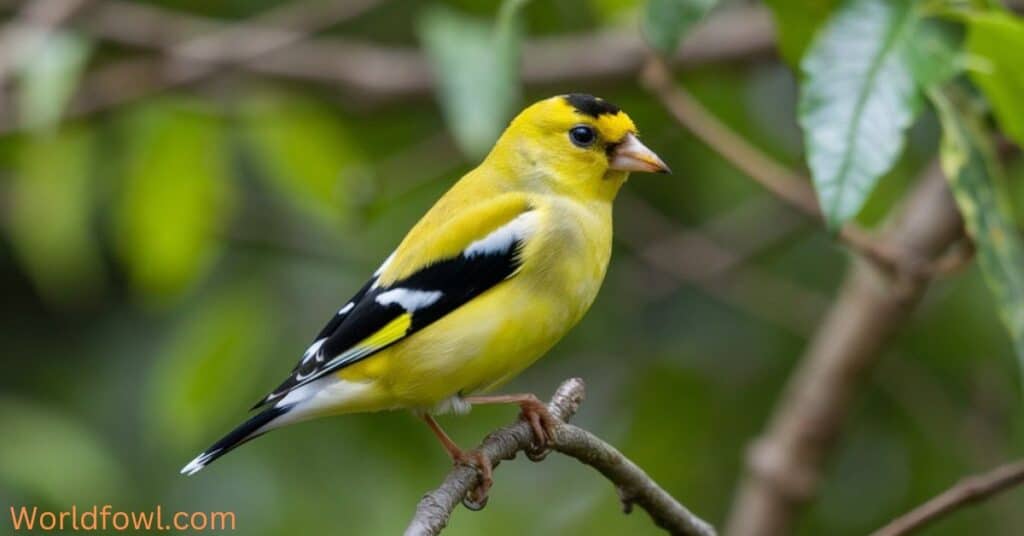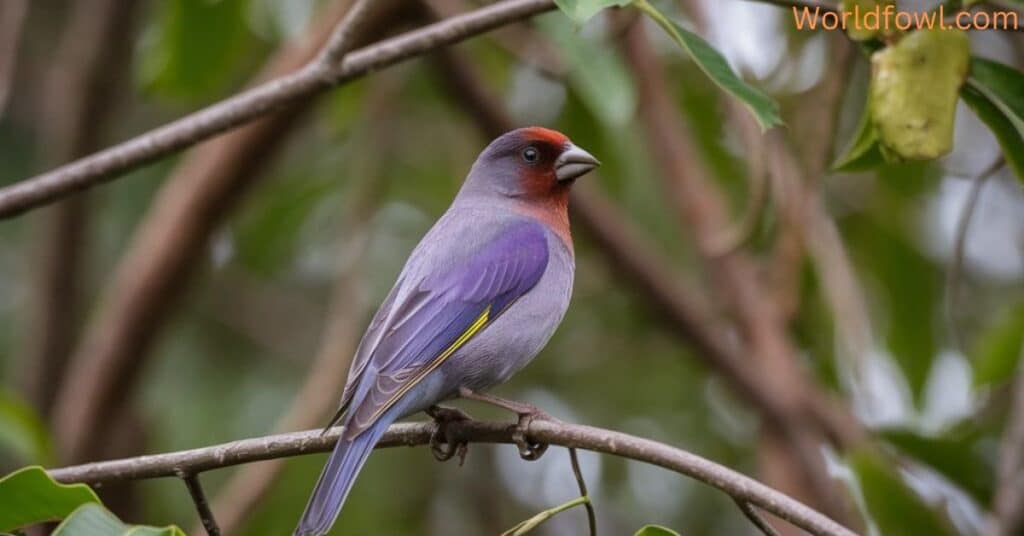Finches In Georgia, with its rich biodiversity and varied ecosystems, serves as a vital habitat for numerous bird species. Among these, finches stand out for their vibrant colors, melodious songs, and fascinating behaviors. This comprehensive guide explores five key finch species found in Georgia: the American Goldfinch, House Finch, Pine Siskin, Purple Finch, and Red Crossbill. We’ll delve into their identification, behavior, habitat preferences, diets, seasonal patterns, and conservation status. Whether you’re a seasoned birdwatcher or a casual observer, this guide aims to enhance your appreciation for the finches in Georgia.
Types of Finches in Georgia
Understanding the different types of finches and their unique characteristics enriches your birdwatching experience. Let’s explore these five notable Finches In Georgia .
American Goldfinch

The American Goldfinch (Spinus tristis) is perhaps one of the most recognizable Finches In Georgia, known for its striking appearance and cheerful song.
Identification
- Males: During the breeding season, male American Goldfinches display vibrant yellow plumage with black wings and a cap. They measure about 4.5 to 5.5 inches in length. Their bright colors peak from late spring to early summer.
- Females: Females are generally more subdued, sporting a warm olive-yellow coloration with lighter underparts. Both sexes have a distinctive short, conical bill suited for seed eating.
Habitat Preferences
- Open Fields and Gardens: American Goldfinches favor habitats rich in flowers and seeds. They are often spotted in open fields, weedy gardens, and along roadsides where thistles and dandelions grow.
- Urban Areas: These finches adapt well to suburban settings and are frequent visitors to bird feeders, particularly those stocked with sunflower seeds and thistle (nyjer) seed.
Behavior and Diet
- Feeding Habits: Their diet primarily consists of seeds from various plants, particularly sunflowers, dandelions, and thistles. They are adept at feeding upside down, allowing them to access seeds that other birds might overlook.
- Social Behavior: American Goldfinches are social birds, often seen in small flocks. Males sing to establish territory and attract mates, producing a cheerful, warbling song that brightens the atmosphere of their habitats.
Seasonal Patterns
- Breeding Season: The American Goldfinch breeds later than many other species, typically from late May to August. This timing coincides with peak seed availability, ensuring a sufficient food supply for their young.
- Migration: In the winter, some populations migrate south, while others remain in Georgia if food sources are abundant. They often join mixed-species flocks during the winter months.
you may also like : Finches In Texas – The Complete Guide To Texas Finches
House Finch

The House Finch (Haemorhous mexicanus) is a common resident throughout Georgia and is easily recognizable due to its adaptability to urban environments.
Identification
- Males: Male House Finches are characterized by their bright red or orange coloration on the head and chest, with streaked brown wings and backs. They measure about 5.5 to 6.5 inches in length.
- Females: Females are more understated, sporting a brown and streaked appearance that aids in camouflage. Their subtle coloration allows them to blend into their surroundings while nesting.
Habitat and Distribution
- Urban Areas: House Finches thrive in cities and suburbs, often found in parks, gardens, and near bird feeders. Their adaptability to human environments is a key factor in their success.
- Nesting Sites: They are opportunistic nesters, commonly building nests in eaves, ledges, and hanging planters. Their ability to utilize human structures for nesting contributes to their widespread distribution.
Social Behavior
- Flocking: House Finches are social and often seen in small groups. Males engage in song to establish territory and attract mates, displaying a range of vocalizations.
- Nesting Habits: House Finches often build nests with a variety of materials, including twigs, string, and paper. They typically lay 2 to 6 eggs per clutch, and both parents help feed the young.
Diet Details
- Omnivorous Diet: House Finches have a diverse diet that includes seeds, fruits, and even insects. This flexibility in feeding habits allows them to thrive in various environments.
- Feeding at Bird Feeders: They frequently visit feeders, especially those containing sunflower seeds, millet, and corn, making them a common sight in many backyards.
Pine Siskin

The Pine Siskin (Spinus pinus) is a small finch often overlooked due to its understated coloration, but its behaviors and feeding habits are quite captivating.
Identification Tips
- Appearance: Pine Siskins are streaked brown birds with yellow markings on their wings and tails, measuring about 4.5 to 5.5 inches in length. Their distinctive markings become more pronounced during flight.
- Behavior: They exhibit a lively demeanor, often flitting from branch to branch in search of food, making them entertaining to observe.
Preferred Habitats
- Coniferous Forests: Pine Siskins favor habitats rich in coniferous trees, particularly pines and spruces. They can also be found in shrubby areas and gardens during migration.
- Seasonal Movement: During winter months, Pine Siskins may move south from their breeding grounds in search of food, often congregating in flocks.
Behavior and Feeding
- Social Structure: Pine Siskins are highly social and often seen in large flocks. Their strong flocking instinct becomes particularly evident during the winter months.
- Feeding Habits: Their diet primarily consists of seeds, particularly from coniferous trees. They are also known to feed on dandelions and sunflowers when other food sources are scarce.
Migration Patterns
- Movements: Some populations of Pine Siskins are resident, while others migrate based on food availability. Their movements can vary widely, making them unpredictable visitors in some areas.
you may like : Parrots in Florida – The Complete Guide To Wild Parakeets In Florida
Purple Finch

The Purple Finch (Haemorhous purpureus) is known for its rich berry-like coloration and melodic song, making it a delightful sight for Finches In Georgia.
Key Identifying Traits
- Males: Males exhibit a raspberry-red color on their heads, backs, and chests, complemented by streaked brown wings. They measure about 5.5 to 6.5 inches long.
- Females: Females are brown and streaked, resembling House Finches but with a more robust build. Their distinct coloration makes them easier to identify in the field.
Habitat and Lifestyle
- Breeding Grounds: Purple Finches are commonly found in coniferous forests, particularly during breeding season. They thrive in areas with plenty of trees for nesting and foraging.
- Suburban Areas: They also venture into suburban regions where sufficient tree cover is available, making them a familiar sight in some neighborhoods.
Feeding Behavior
- Seed Preferences: Their diet primarily consists of seeds, particularly those from conifers. They also consume fruits and flowers, depending on availability.
- Foraging Techniques: Purple Finches often forage in trees and shrubs, using their strong beaks to crack open seeds and access other food sources.
Breeding and Nesting
- Nesting Habits: They build nests in trees, often selecting conifers for shelter and safety. The female typically lays 3 to 5 eggs, which both parents help incubate.
- Seasonality: Breeding occurs in late spring and summer, aligning with peak food availability for feeding their young.
Red Crossbill

The Red Crossbill (Loxia curvirostra) is a unique finch known for its distinctive crossed bill, which is perfectly adapted for extracting seeds from conifer cones.
Unique Features for Identification
- Distinctive Bill: The crossed bill allows Red Crossbills to pry open pine cones, providing access to seeds that many other birds cannot exploit. This adaptation sets them apart from other finch species.
- Coloration: Males are bright red, while females typically appear yellow or brown. They measure about 5.5 to 6.5 inches, with their bill shape being the most distinctive feature.
Habitat Requirements
- Coniferous Forests: Red Crossbills prefer habitats rich in coniferous trees, especially pines and spruces, where they can find their primary food source. They are often found in mountainous or hilly regions.
- Winter Movements: These finches are known for their nomadic behavior, often moving to different areas in search of food, making their presence unpredictable.
Feeding Habits
- Specialized Diet: Their diet consists mainly of seeds from coniferous trees, with their unique feeding strategy allowing them to extract seeds efficiently. They can feed on a variety of conifer species, making them adaptable foragers.
- Flocking Behavior: Red Crossbills are often seen in large groups while foraging, which helps them cover more ground and find food sources more effectively.
Social Behavior
- Migratory Patterns: These finches are highly migratory and often move based on food availability. Their social structures are complex, and they communicate through various vocalizations, which vary by region.
you may also like : Do Owls Migrate? Examining Owl Migration Facts and Myths
Rare Finches in Georgia

While the five species discussed above are commonly found Finches In Georgia, the state occasionally welcomes rare finch visitors. Birdwatchers may spot species like the Evening Grosbeak and the Common Redpoll during their migratory travels.
Overview of Rare Finches
- Evening Grosbeak: This large finch is known for its striking yellow and black coloration. Rarely seen in Georgia, it typically migrates through the state during winter months, often visiting feeders stocked with sunflower seeds.
- Common Redpoll: A small finch with a distinctive red cap, known for its sociable nature. These birds are usually found in northern climates but may wander southward during harsh winters.
Tips for Birdwatchers
If you’re keen to spot rare finches, consider the following tips:
- Best Times to Spot Rare Finches: Late fall and winter months are prime for viewing migrating finches, particularly around bird feeders stocked with suitable seeds.
- Ideal Locations: Areas with abundant food sources, like feeders stocked with sunflower seeds or thistle, are excellent for attracting both common and rare finches.
- Patience and Observation: Bring binoculars and a field guide, and be prepared to spend time quietly observing. Patience often rewards birdwatchers with delightful sightings.
The Importance of Finch Conservation
Understanding and appreciating finches goes hand in hand with conservation efforts. Many Finches In Georgia face threats from habitat loss, climate change, and urbanization. Here’s why it matters:
Ecosystem Roles
Finches play vital roles in their ecosystems, including:
- Seed Dispersal: By feeding on seeds and fruits, finches help disperse plant species, contributing to forest regeneration and plant diversity.
- Prey for Other Species: As a part of the food web, finches serve as prey for larger birds and mammals, helping maintain ecological balance.
Habitat Preservation
Preserving natural habitats ensures that finches and other wildlife can thrive. Steps you can take include:
- Support Local Conservation Efforts: Participate in or donate to organizations focused on preserving natural habitats in Georgia, such as the Georgia Audubon Society or the National Audubon Society.
- Create Bird-Friendly Spaces: In your own yard, you can plant native shrubs and trees that provide food and shelter for finches and other birds. Avoid using pesticides that can harm birds and their food sources.
Citizen Science
Participating in citizen science projects can aid in monitoring finch populations and habitats. Resources like the Great Backyard Bird Count encourage individuals to report their observations, contributing valuable data for research and conservation efforts.
Engaging with Georgia’s Finch Community
Birdwatching can be more than a solitary hobby; it can be a way to connect with others who share your passion for nature.
you might also like : Where Do Mourning Doves Nest – A Complete Guide To Baby Mourning Doves
Joining Local Birdwatching Groups
Consider joining local birdwatching clubs or societies. These groups often organize events, outings, and educational programs that can enhance your knowledge and enjoyment of Georgia’s finches.
- Georgia Audubon Society: This organization offers resources, events, and programs aimed at promoting bird conservation and education in the state. Visit their website to find local chapters and upcoming events.
- Birding Festivals: Participate in birding festivals across Georgia, which often feature guided birdwatching tours, presentations, and opportunities to see rare species. Events like the Georgia Bird Fest provide a great platform to connect with fellow enthusiasts.
Attending Workshops and Educational Programs
Many organizations and local parks offer workshops and educational programs focusing on bird identification, conservation, and photography. These programs not only enhance your birdwatching skills but also allow you to connect with experts and fellow bird lovers.
Creating a Finch-Friendly Habitat
If you’re looking to attract more finches to your backyard, consider the following tips to create a welcoming environment:
Choose the Right Bird Feeders
- Types of Feeders: Select feeders designed specifically for finches, such as tube feeders for thistle seeds and platform feeders for sunflower seeds.
- Placement: Position feeders in locations that offer some shelter, such as near trees or shrubs, to provide safety from predators.
Provide a Diverse Diet
- Seed Varieties: Stock feeders with a variety of seeds, including sunflower seeds, thistle, and millet, to attract different finch species.
- Fresh Water: Provide a shallow birdbath for drinking and bathing, as water is essential for birds, especially during dry spells.
Plant Native Species
- Native Plants: Incorporate native plants in your landscaping, which can provide natural food sources and shelter for finches. Plants like coneflowers, sunflowers, and milkweed attract finches and other beneficial wildlife.
- Create Natural Habitat: Leave some areas of your yard wild with native grasses and wildflowers to encourage foraging and nesting.
Conclusion
Georgia’s finches represent a fascinating and colorful array of avian life, each species contributing uniquely to the environment. From the cheerful American Goldfinch to the elusive Red Crossbill, these birds offer endless opportunities for observation and appreciation.
Maintaining bird feeders stocked with a variety of seeds can attract these beautiful finches to your yard, providing a front-row seat to their fascinating behaviors. So grab your binoculars, and get ready to enjoy the lively spectacle of finches in Georgia!

Henry James is a seasoned blogger and a passionate storyteller on “World Fowl.” With years of experience crafting engaging content, he brings a unique blend of expertise and creativity to his writing. Henry specializes in exploring diverse topics with depth and clarity, captivating readers worldwide.







